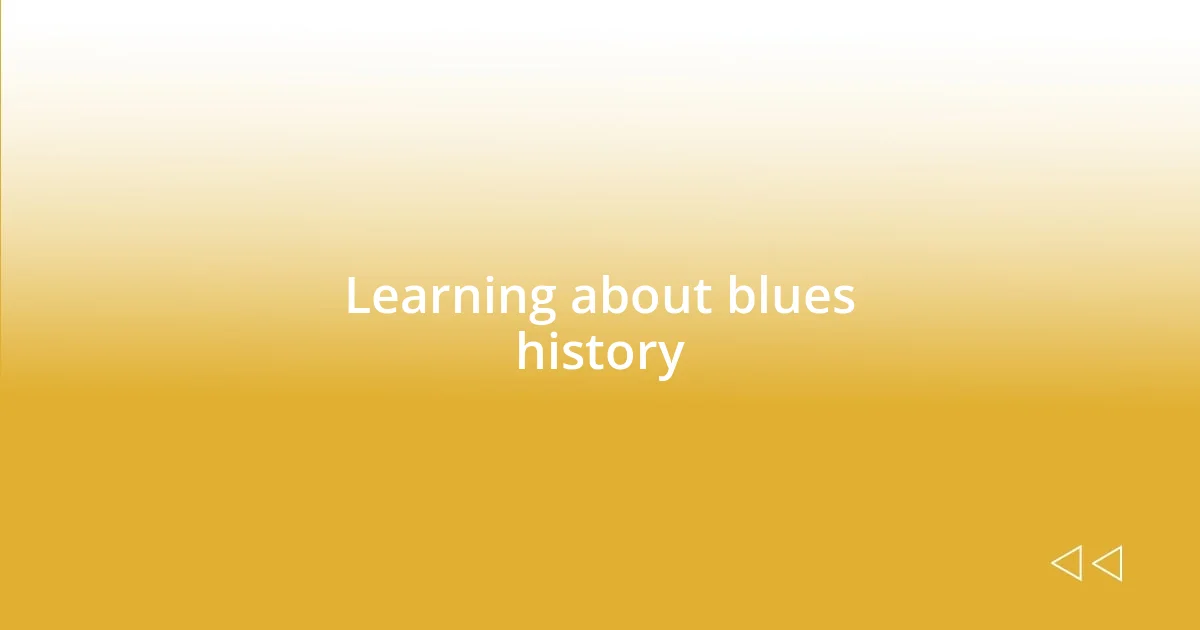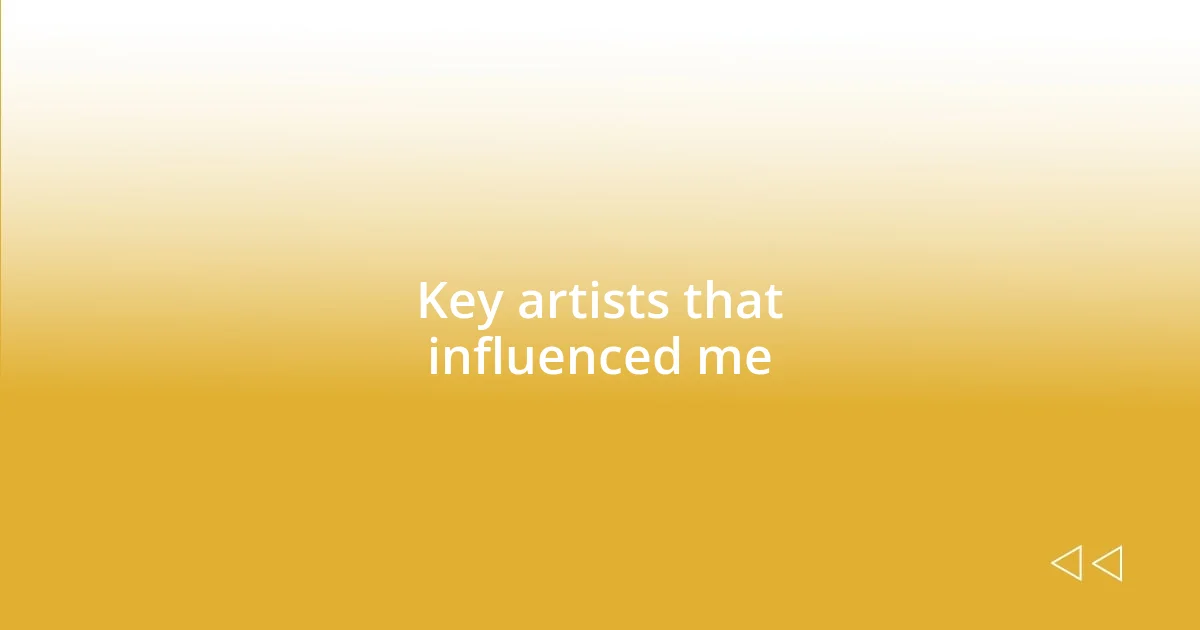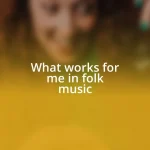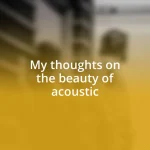Key takeaways:
- Discovery of musical roots: The author uncovers family history connected to music, particularly through their grandparents’ passion for jazz and blues.
- Emotional connection to blues: The author’s first live blues experience evokes deep feelings and a realization of music as a conversation about past and present emotions.
- Personal musical evolution: The author explores various blues genres, develops a unique style, and finds joy in blending influences while performing, expressing resilience and hope through music.

Discovering my musical roots
As I dug through old family albums, I stumbled upon photographs of my grandparents at vibrant jazz clubs, their faces lit up with joy. It struck me how music was woven into the fabric of our family history. Could it be that some of their passion had been passed down to me?
I recall the first time I heard B.B. King’s guitar wail on the radio. It was as if the air crackled with emotion, awakening something deep within me. The raw power of his blues had me feeling connected to those long-lost roots, igniting a curiosity that pushed me to explore the genre further. What stories were hidden within those bluesy notes just waiting for me to uncover?
Searching for my musical identity, I started visiting local blues bars. Each night felt like a treasure hunt for sound, where every note layered over my memories, connecting me to a rich heritage. I found myself asking, “What does this music mean to me?” In those spaces, I felt not just a viewer, but a participant in an ongoing narrative—my narrative.

My first encounter with blues
The first time I truly encountered blues was during a rainy evening spent at a local coffeehouse. I was nursing a cup of dark roast when an acoustic trio took the stage, and as the first notes filled the air, I felt a rush of warmth and familiarity wrap around me. It was almost like the music had a pulse, echoing the heartbeats of the performer and the audience alike, connecting us in that dimly lit room.
- I remember how my heart raced when the lead singer shared stories of heartache and resilience.
- The sound of his voice, rough yet soothing, spoke directly to my soul.
- For the first time, I understood how music could capture emotions I couldn’t quite express.
That night, I fell head over heels, realizing that blues was more than just a genre; it was a conversation between the past and present, and I knew I wanted to be a part of that dialogue.

Learning about blues history
Learning about blues history was like peeling back layers of a musical onion. I remember sitting in my cozy living room, surrounded by books on the genre, and feeling a sense of wonder as I read about its deep roots in African American culture. The stories of hardship and resilience resonated with my own experiences, and I found myself captivated by the lives of legends like Muddy Waters and Howlin’ Wolf. Their journeys from struggles to stardom painted a vivid picture that made the music feel even more alive.
Diving deeper, I discovered the rich history of blues as it evolved through different regions and styles. Just learning about the Delta blues and its raw, acoustic sound made me appreciate the genre’s authenticity even more. I used to listen to sonorous recordings of these early artists, imagining the dusty roads they walked and the emotions they poured into their craft. Each note seemed to echo the stories they carried within their hearts.
In a small blues festival, I once spoke to a local artist who shared tales of how the blues influenced not just music, but also social change. His passion was contagious, and it made me realize that blues is not just a genre; it’s a powerful narrative of history and culture. The more I engaged with this history, the more my connection to the genre grew, grounding my passion for blues in a rich tapestry of human experience.
| Blues Era | Key Characteristics |
|---|---|
| Delta Blues | Raw acoustic style, heartfelt lyrics, often tied to personal stories and struggles |
| Chicago Blues | Electric instrumentation, more vibrant sound, often features harmonica and piano |
| Contemporary Blues | Blending of genres, incorporating rock, jazz, and even hip-hop influences |

Key artists that influenced me
Some artists have left a profound mark on my journey into the blues, and I can’t help but think of B.B. King. His ability to convey emotion through a single note blew my mind; it was as if each bend of his guitar string whispered secrets of joy and sorrow. I still recall the first time I listened to “The Thrill is Gone.” I felt every ounce of longing in his voice. It made me wonder—how could music capture such depths of feeling?
Then there’s Etta James, whose powerful and soulful delivery made me rethink what it meant to be vulnerable in music. I remember cooking dinner one evening with her song “At Last” playing softly in the background. As I chopped vegetables, the richness of her voice sank into my bones, making me realize how music can amplify love and loss simultaneously. Could it be that her passion fueled my desire to explore my own emotions through songwriting?
Lastly, I can’t overlook the influence of Robert Johnson, the legendary figure whose haunting melodies and mysterious life story ignited my curiosity. I recall one rainy afternoon, I stumbled upon a documentary about him while scrolling through channels. It was as if his spirit was lingering through the screen, and I felt a pull to discover more about the man behind the music. What was it about those crossroads that still resonates with so many? His story made me appreciate the rawest forms of expression, and sparked a desire in me to explore my own creative crossroads, just like he did.

Exploring different blues genres
Exploring different blues genres opened my eyes to a world that’s so beautifully diverse. One evening, while flipping through a vinyl collection, I unearthed a Chicago blues album that changed everything for me. The electrifying guitar riffs and spirited harmonica made me want to dance, showcasing how this genre seamlessly blends joy with the weight of life’s struggles. How could one sound convey both?
As I ventured into the realm of Contemporary blues, I was blown away by how artists were fusing traditional sounds with elements from rock and hip-hop. I still remember my first concert where a younger artist incorporated a DJ scratch along with his soulful melodies. It felt revolutionary! This blend of genres made me realize that blues is not static; it’s a living, breathing form of art that evolves while still honoring its roots. I found myself wondering, what new stories could this ever-changing genre tell?
I often revisit the Delta blues, especially when I seek that visceral connection to the emotional landscape it offers. One memorable night, I joined friends around a bonfire, strumming a simple chord progression that echoed the essence of this genre. Each pluck of the string felt like a conversation with the spirits of artists long gone, stirring a deep appreciation for their heartfelt storytelling. It raises the question: doesn’t every strum remind us of our shared humanity? For me, diving into these sub-genres of blues has been not just an exploration, but a journey into the deepest parts of my soul.

Attending live blues performances
Attending live blues performances was like stepping into a world where every note told a story. I clearly remember my first experience at a small jazz club, the air thick with anticipation. As the band took the stage, a sense of connection washed over me—here were musicians pouring their hearts out, sharing their pain and joy. It was transformative; I finally understood the infectious energy that live blues brings. Doesn’t it feel like you’re part of something greater?
I vividly recall one night in particular when an older gentleman with a weathered guitar shared his craft. The way he bent the strings made my heart race, as if I could feel each note thrumming through the floorboards and into my soul. It was both exhilarating and grounding; how could a simple performance unravel the complexities of human emotions so effortlessly? Watching him perform, I felt a yearning to embrace my own vulnerabilities, exploring some of my deepest emotions through my artistry.
At another show, I was captivated by the improvisation between the musicians on stage. They seemed to communicate without words, each riff and solo a conversation. I found myself lost in their world, pondering how blues allows artists to push boundaries and redefine emotional expression night after night. Isn’t it remarkable how the spontaneity of live performances creates a unique bond between the artist and the audience? I left with a fire in my heart, eager to replicate that raw authenticity in my own music journey.

Developing my own blues style
Developing my own blues style became a journey of self-discovery and experimentation. I remember setting up my old guitar in my living room, determined to find a sound that resonated with my soul. It was during one of those late-night jam sessions that I stumbled upon a subtle finger-picking technique, reminiscent of those soulful Mississippi musicians. Was it possible that within that simple strum lay my unique voice waiting to be heard?
As I delved deeper, I started mixing influences—adding a touch of jazz and even a sprinkle of folk to my blues. One rainy afternoon, I sat on my porch, pen in hand, trying to capture the melancholy of the weather in a new song. The fusion felt liberating; I was crafting something that was distinctly mine. Isn’t it fascinating how blending styles can unlock new emotions?
I can’t forget the exhilaration of playing at an open mic night for the first time. As I performed my original piece, I glanced around and saw nodding heads and tapping feet. This electric connection with the audience fueled my imagination, urging me to dig deeper into my experiences. In that moment, I realized my blues was not just about sadness, but also a reflection of resilience and hope. How could I express this rich tapestry of feelings in every note?















